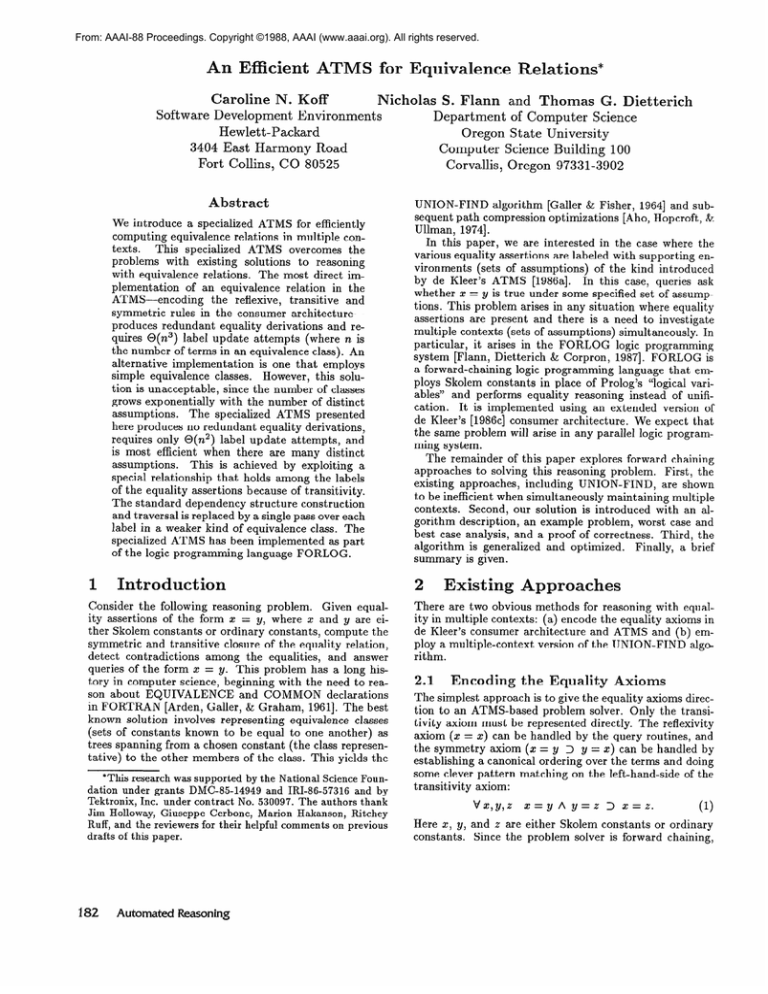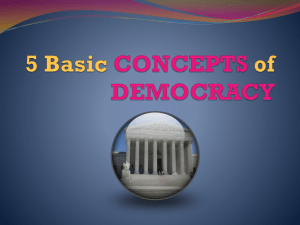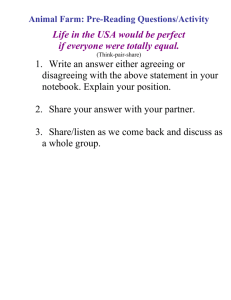
From: AAAI-88 Proceedings. Copyright ©1988, AAAI (www.aaai.org). All rights reserved.
An Efficient
ATMS
for Equivalence
Relations*
Caroline N. Koff
Nicholas S. Flann and Thomas G. Dietterich
Software Development Environments
Department of Computer Science
Hewlett-Packard
Oregon State University
3404 East Harmony Road
Computer Science Building 100
Fort Collins, CO 80525
Corvallis, Oregon 97331-3902
Abstract
We introduce a specialized ATMS for efficiently
computing equivalence relations in multiple contexts.
This specialized ATMS overcomes the
problems with existing solutions to reasoning
with equivalence relations. The most direct implementation of an equivalence relation in the
ATMS-encoding
the reflexive, transitive and
symmetric rules in the consumer architectureproduces redundant equality derivations and requires O(n3) label update attempts (where n is
the number of terms in an equivalence class). An
alternative implementation is one that employs
simple equivalence classes. However, this solution is unacceptable, since the number of classes
grows exponentially with the number of distinct
assumptions. The specialized ATMS presented
here produces no redundant equality derivations,
requires only O(n2) label update attempts, and
is most efficient when there are many distinct
This is achieved by exploiting a
assumptions.
special relationship that holds among the labels
of the equality assertions because of transitivity.
The standard dependency structure construction
and traversal is replaced by a single pass over each
label in a weaker kind of equivalence class. The
specialized ATMS has been implemented as part
of the logic programming language FORLOG.
1
Introduction
Consider the following reasoning problem. Given equality assertions of the form z = y, where x and y are either Skolem constants or ordinary constants, compute the
symmetric and transitive closure of the equality relation,
detect contradictions among the equalities, and answer
queries of the form x = y. This problem has a long history in computer science, beginning with the need to reason about EQUIVALENCE and COMMON declarations
in FORTRAN [Arden, Galler, & Graham, 19611. The best
known solution involves representing equivalence classes
(sets of constants known to be equal to one another) as
trees spanning from a chosen constant (the class representative) to the other members of the class. This yields the
*This research was supported by the National Science Foundation under grants DMC-85-14949
and IRI-86-57316
and by
Tektronix, Inc. under contract No. 530097. The authors thank
Jim Holloway, Giuseppe Cerbone, Marion Hakanson, Ritchey
Ruff, and the reviewers for their helpful comments on previous
drafts of this paper.
182
Automated Reasoning
UNION-FIND algorithm [Galler & Fisher, 19641 and subsequent path compression optimizations [Aho, Hopcroft, &
Ullman, 19741.
In this paper, we are interested in the case where the
various equality assertions are labeled with supporting environments (sets of assumptions) of the kind introduced
by de Kleer’s ATMS [1986a]. In this case, queries ask
whether x = y is true under some specified set of assumptions. This problem arises in any situation where equality
assertions are present and there is a need to investigate
multiple contexts (sets of assumptions) simultaneously. In
particular, it arises in the FORLOG logic programming
system [Flann, Dietterich & Corpron, 19871. FORLOG is
a forward-chaining logic programming language that employs Skolem constants in place of Prolog’s “logical variables” and performs equality reasoning instead of unification. It is implemented using an extended version of
de Kleer’s [1986c] consumer architecture. We expect that
the same problem will arise in any parallel logic programming system.
The remainder of this paper explores forward chaining
approaches to solving this reasoning problem. First, the
existing approaches, including UNION-FIND, are shown
to be inefficient when simultaneously maintaining multiple
contexts. Second, our solution is introduced with an algorithm description, an example problem, worst case and
best case analysis, and a proof of correctness. Third, the
algorithm is generalized and optimized. Finally, a brief
summary is given.
2
Existing
Approaches
There are two obvious methods for reasoning with equality in multiple contexts: (a) encode the equality axioms in
de Kleer’s consumer architecture and ATMS and (b) employ a multiple-context version of the UNION-FIND algorithm.
2.1
Encoding
the Equality
Axioms
The simplest approach is to give the equality axioms direction to an ATMS-based problem solver. Only the transitivity axiom must be represented directly. The reflexivity
axiom (x = x) can be handled by the query routines, and
the symmetry axiom (5 = y > y = 2) can be handled by
establishing a canonical ordering over the terms and doing
some clever pattern matching on the left-hand-side of the
transitivity axiom:
vx,y,z
x=y
A y=z
3
x=z.
(1)
Here x, y, and z are either Skolem constants or ordinary
constants.
Since the problem solver is forward chaining,
label-update algorithm will recursively update the consequent node labels by traversing justification links. Consider the following series of label update attempts made
by the label-update algorithm after node1 has been updated to include the environment {C} in its label. First,
the algorithm attempts to update the labels of nodel’s
consequent nodes, node2 and node3:
For node2’s label, the new environment of nodel,
namely {C}, and the environment of node3, namely
{A, B},
are combined by taking the union to produce the environment {A, B, C}, which is subsumed
by nodea’s existing environment, {B}.
Figure 1: The dependency structure for three equalities
whenever the antecedent pattern of this axiom is satisfied
by a set of facts in the database during problem solving, a
new assertion is derived and added to the ATMS database
as an ATMS node. For example, consider the following
two equality assertions (presented using the basic ATMS
node data structure: node:(datum, label, justifications)):
node1
: (skl = Sk23 WH’
um7
(2)
node2
: (Sk2 = Sk%
WY/).
(3)
WH,
These satisfy the antecedents of (1) and produce the following derived node:
node3
: (Sk1 = sk3,
{{A,
B}},
{(nodel,
nodea)}).
(4)
is the only new equality information derivable from
and node2.
But by applying the symmetry axiom, the newly derived equality in node3 will twice satisfy
the antecedent of (1) in conjunction with the equalities in
node1 and node2 respectively, and rederive the following
two equalities:
Node3
node1
node1
: (skl = sk2,
{{A,
B)},
((node2,
node3))),
(5)
node2
: (sk2 = sk3,
{{A,
B}},
{(nodel,
node3))).
(6)
One of the requirements imposed on the labels by the
ATMS is that they be in minimal form. Since the environment {A, B) of (5) and (6) is subsumed by {A} of node1
and {B} of node2, it is not included in the labels of nodes
node1 and node2.
In this sense, the equality derivations
of (5) and (6) are redundant. However these redundant
derivations allow the problem solver to generate all of the
necessary justification links for these three nodes. Without
these justification links, the ATMS cannot apply its labelupdate algorithm correctly. The dependency structure for
these three nodes is given in Figure 1. (Justifications for
each equality assertion are shown as two links merging to
support that assertion.)
Although de Kleer’s label-update algorithm [de Kleer,
19SSa] guarantees that the labels will be consistent and
complete upon termination of the update process, each
node label may have been updated more than once.
By applying this algorithm to a collection of mutuallysupporting assertions, such as those shown in Figure 1, an
alarming number of label update attempts will occur due
to the circular structure of the dependencies. For example,
suppose a node is given a new supporting environment.-To
propagate this environment to the rest of the nodes, the
For node3’s label, the new environment of nodel,
namely {C}, and the environment of node2, namely
are combined to produce the environment
W’
{B, C} which is included in node3’s label.
Since node3’s label has changed (i.e., has been actually
updated), the algorithm will now attempt to update the
labels of node3’s consequent nodes, node1 and node2:
o For nodel’s label, the new environment of node3,
namely {B, C}, and the environment of node2, namely
WI’ are combined to produce the environment
{B, C}, which is subsumed by nodel’s existing environment, {C}.
8 For node2’s label, the new environment of node3,
namely {B, C}, and the environments of node1 are
combined to produce the environments {A, B, C} and
ic h are subsumed by node2’s exist{B,C}
both o f w h’
ing environment, {B}.
The example given above does not demonstrate the worst
case. This occurs when new support arrives on a derived node, such as node3-the
algorithm must traverse
G ,
every justification of every node. Since there are
(
>
or n(n - 1)/2 equalities, where n is the number of terms
in an equivalence class, and there are n - 2 ways to justify
an equality, the number of label update attempts made by
the algorithm is n(n - l)(n - 2)/2 or O(n3).
The best case occurs when the algorithm terminates after attempting to update just one label upon either deriving a nogood (an environment that supports a contradictory fact) or deriving an environment that was subsumed
by the node label’s existing environments.
One approach to reducing the generation of redundant
equality assertions is to employ typed consumers. The ba
sic idea is to postpone construction of the circular dependency links until they are needed to allow label propagation
and updating. The example used by de Kleer [1986c] is the
relation pbus(x, y, z). Such relations are implemented by a
set of constraint consumers, one for each variable that computes its value from the values of the other variables. For
example, when x and y are known, a constraint consumer
computes the value for z. However, this value for z will
be used with x (or y) and another constraint consumer to
recompute y (or x). To avoid such redundancies, a special
mechanism was proposed by de Kleer that involved assigning a unique type to each constraint consumer of a relation
and barring the use of data derived from such consumers
to satisfy other consumers of the same type. This prevents
the circular justifications and redundant assertions from
being created until additional support is given to the value
Koff, Flann and Dietterich
183
for Z. At that point, the justifications will be created so
that this new support can be propagated to x and to y.
Because redundant assertions and circular justifications
are eventually created, typed consumers do not improve
the worst-case behavior of this approach to equality reasoning.
2.2
Extending
A Specialized
ATMS
for
Equivalence
Relations
Both of the approaches given above for implementing
equality reasoning under multiple contexts are inefficient
either because they construct explicit justification links
or because they use the implicit justification structure of
equivalence classes. The method described below avoids
both of these problems by using a weaker kind of equivalence class and exploiting special properties of the ATMS
labels. It does not construct any explicit justification links.
There are three components to this specialized ATMS: the
equality database (hereafter, ED), the problem solver, and
the label-update algorithm.
3.1
The Equality
Database
The equality database consists of equality nodes and equivalence class nodes. The equality node is like the ATMS
node, but it has no justifications, and its datum is an
equality assertion such as x = y. All equality assertions,
whether given or derived, are explicitly represented by
equality nodes. Hence, in the worst case, we will have
O(m’) equality nodes in ED, where m is the total number
of terms known.
The equivalence class node lists the terms (and assertions) that belong to that equivalence class. The notion of
equivalence class employed for the remainder of the paper
is the following: a weak eqtiivalence class is a maximal set
of terms that are weakly equivalent. Two terms tl and
t2 are weakly equivalent if there exists an environment under which tl = t2 is true. Note that the environment in
184
Automated Reasoning
w33
sk2
sk3
Figure 2: The equivalence class from Figure 1
UNION-FIND
The second approach is to employ some kind of equiva
lence class data structure like the UNION-FIND tree. An
equivalence class is a set of constants and Skolem constants
that are all equal to one another in a single context. In
single-context systems (like Prolog and RUP [McAllester,
19821)) the context in question is implicit, and this is very
efficient.
However, when we move to multiple context systems like de Kleer’s ATMS, the number of equivalence
Suppose we have three equality asclasses explodes.
(a = Y, (B}),
and (a =
sertions:
(a = u, {A}),
w, {C}). In this case, four non-trivial equivalence classes
must be constructed:
bvvH4Bh
bvw~b%C~,
and {a, u, v, w}(A) B, C}. If we only conbv,wWW~,
structed the last class, we would not be able to answer the
query (u = 21, {A, B}) correctly. What is happening is
that every distinct context gets its own equivalence class.
Since there are 2” contexts for k primitive assumptions,
this results in an exponential explosion. Hence, this solution is unacceptable.
3
ski
question need not be the same for all pairs of terms in the
class.
The terms of an equivalence class under this definition
form the nodes of a complete graph. The edges of the graph
are equality assertions. The edge from node tl to node t2
asserts that tl = t2. Figure 2 shows the equivalence class
of Figure 1 using this notation. The edges are labeled with
the ATMS labels for the corresponding equality nodes.
3.2
The Problem
Solver
The problem solver of the specialized ATMS is given equalities of the form tl = t2 with their corresponding labels.
Its task is to create and maintain equivalence class nodes
by deriving new equality nodes from the given assertion.
To differentiate the nodes derived by the problem solver
from the nodes given to the problem solver, we will call
the latter the vri‘mitive equalities, and their environments,
the Primitive invironments.
Let us assume for now that
eachof the primitive environments introduced to the problem solver is disjoint.
For the purpose of describing how the new equality nodes
are derived, let Eq be the primitive equality tl = t2,
with IE~ as its label consisting of only primitive environments, and let EC1 and EC2 be two separate equivLet
alence class nodes of size n1 and n2 respectively.
Label be a function which takes an equality and returns
its label. Let Combine be a function which takes two
labels, dl and 62, and produces a new label by putting
in a minimal form the set of environments d,,,, where
dnew = {envli U eTlV2j 1 envli E dl A enV2j E 12).
The four cases that must be considered for deriving new
equality nodes are given below.
Case 1: If neither tl nor t2 exist in any of the equivalence
class nodes in ED, i.e., both tl and t2 are new terms never
before encountered, create and assert into ED an equality
node with Eq and bEq, and an equivalence class node listing
tl and t2.
case 2: Sunnose tl E EC1, but t2 does not exist in ED,
that is, one yf the terms (in this case, tl) has been previously encountered while the other is being introduced for
the first time. Let EC; = EC1 - {tl}. Then Vti E EC:,
for i = 1 . . . nl - 1, create and assert into ED an equality
node with the equality t2 = ta, where its label is computed
as Corn bine( I,r+, Labe!(tl = ti)). Th en, create and assert
into ED an equality node for Eq and dam, and add t2 to
EC1.
Case 3: Suppose tl E EC1 and t2 E EC2, that is, both
terms were previously encountered but were never previously equated. Let EC{ = EC1 - {tl} and EC;
=
EC2 - (t2).
Then Vti E EC:,
for i = 1.. .n1 - 1, and
Vtj E EC;,
for j = I... n2 - 1, create and assert into ED
the following:
Figure 3: Before the label updates
Figure 4: After the label updates
8 An equality node with ta = tj and its label computed
as: Combine(lE,,Combine(Labed(tl
= ti),
Label(t2
e An
as:
e An
as:
Label(t2
The Label-Update
e For each la E &p&&s do:
e For each envi,j E li do:
@ For each envOld,k E lOld do:
1. If (e~?JO~d,k
fl enva,j) = 8, do nothing.
2. Else, compute a new environment to be
added to di as:
G3 en%,j)
U enhew
o If the newly computed environment is
not subsumed by any environment in da
then add it to li.
3.3.2
(({A)
j
({A)
HlVij
n envij)
@ envi,j)
WV
An Example
Consider the equivalence class shown in Figure 3. Suppose new environment {D} arrives on the label for sbl =
sk2. The updated label for this entry node is {{A},
{D}},
I$ is the disjoint union operation
(A - B) u (B - A).
defined as:
and enVO1d,Jis {A} and env,,,
is {D}.
The other labels
in the equivalence class shown in Figure 3 are updated
as prescribed by the label-update algorithm given above.
The results of applying the steps are summarized in Table
1. The updated equivalence class of Figure 3 is shown in
Figure 4. Note that in this example the algorithm did not
compute any redundant environments.
3.3.3
Algorithm
3.3.1
The Algorithm
The label-update procedure is given an existing equality
node, called the entry node, along with a new environment,
env,,,
. Its task is to add this new environment to the
existing label, dold, of the entry node and to update all the
labels of the other equality nodes in the equivalence class.
Let L updatesbe the set of all labels in the equivalence class
containing the entry node, but not including lOId. The
procedure is as follows:
* (en%ld,k
i
= tj)).
Hence, the number of new equalities derived from joining
EC1 and EC2, is (nr - l)(na - 1) + (nl - 1) + (722- 1) =
nln2
- 1. Finally, create and assert into ED an equality
node for EQ and bEg, and update EC1 to be EC1 U EC2.
Case 4: When tl, t2 E ECl,
that is, both terms were
previously encountered and were also equated, the labelupdate procedure is called, since bEOis providing new environment(s) to be added to the existing label of Eq.
While deriving new equality nodes, if the problem solver
detects a derived equality between two different (nonSkolem) constants (a contradiction), its label is declared
nogood (see [Koff, 19SS]).
3.3
Table 1: Summary of the label-update process
= tj))).
equality node with t2 = ti and its label computed
Combine(lEq,
Labeb(t1 = ti)).
equality node with tl = tj and its label computed
Combine(bE,,
sk2
skl
sk2
ski
A @ I3 =
An Explanation
To see why this algorithm succeeds, consider Figure 5,
which shows a portion of an equivalence class. All of
the equalities with singleton environments are primitive
(given) assertions. Let us focus on the two derived equalities tl = t2 and t5 = t6. Notice two things. First, the
graphical counterpart of the transitivity axiom is a connected path. To compute the environment for t5 = t6, we
find a path from t5 to t6 containing only primitive environments. In this case, the path is (t5, t3, t4,t6),
which
gives us the environment {B, C, E}. Second, the intersection of the environments for tl = t2 and t5 = t6, {C}, is
is, the shared path.
the shared environment-that
Suppose that an environment, {F}, is given as new
support for tl = t2.
The label-update algorithm will,
among other things, update the label for t5 = t6 to include the environment ({A, C, D} $ {B, C, E}) U {F} =
(A,B,D,E,F}.
Th is can be viewed as (a) subtracting
the path shared by the two equalities tl = t2 and t5 = t6
t1
CA3
t3
IB3
mw3
CA,W3
t2
t5
w3
VI
{E)
if5
Figure 5: Shared support and label updates
Koff, Flann and Dietterich
185
and (b) computing a new path, (t5, t3,tl,t2,t4,
t6), that
passes through the newly supported equality tl = t2. In
effect, {F}, along with {A} and {D}, is substituted for the
old shared environment, {C}, to provide a new supporting
environment for t5 = t6. The entire calculation can be
performed without explicitly traversing paths or justification links, since the labels implicitly hold the dependency
structure.
The fact that we are using the labels to obtain the dependencies among the equalities requires that we must retain the nogood environments within the labels. In fact, a
nogood environment cannot be removed from a label until it can be replaced with a non-nogood environment that
implicitly holds the same dependency structure (see [Koff,
19SS]).
3.3.4
Computational
Costs
Since there are n(n - 1)/2 equalities in an equivalence
class with n terms, and since the algorithm always attempts to update all but one of the labels for those equalities, the number of label update attempts is O(n2). This
figure is significantly better than the O(n3) label compututions performed by de Kleer’s algorithm. Moreover, note
from the algorithm that not all label update attempts will
reSUlt
in a label computation (since (env,[d,k fl en?Ji,j) = 0
may be true). In fact, it can be shown that m the best case,
only o(n)
label computations will be performed [Koff,
19881.
3.3.5
Proof of Correctness
We demonstrate the algorithm’s correctness by an inductive proof.
First we consider the base case-a three term equivalence class. Given any two equalities x = y (in environment envl) and y = z (in environment env2) the third
equality z = z can be derived using the transitivity axiom. (We will refer to these simple three way equalities
as ‘triangles’ since they form triangles in the graphical notation introduced earlier.) Since x = z was derived from
the equalities supported with envl and env2, the derived
environment env3, which supports x = z, is defined as
env3 = env2 U envl.
Since we have assumed that envl
and env2 are disjoint environments, the following relationships hold for the three environments in a triangle:
env3
= envl
@ env2
env2
= envl
envl
= env2
Automated Reasoning
Figure 6: Incremental extension of an equivalence class
Suppose an equality Eql is in an equivalence class of size
and Eq3a be the equalities that form the n - 1
triangles with Eql. Now consider new support envlnew arriving on Eql. To update this equivalence class, the labels
of Eq2i and Eq3i for each of the triangles are updated. Let
envl, env2, and env3 be pre-existing environments of Eql,
Eq2i, and Eq3i respectively. According to de Kleer, the
new environments to be added to the labels of Eq2i and
Eq3i (referred to as env2,,,
and env3,,,
respectively) are
computed as follows:
n. Let Eq2i
env%,,=
env3
env3 neM = env2
U envlnew
(10)
U envl,,,
From (7) we can substitute into (lo), and from (8) we can
substitute into (11) to obtain the following two equations:
.
.
I
I
enGew = (envl @ env2) U envl,,,
(12)
= (envl @ env3) U envl,,,
(13)
The equations (12) and (13) directly correspond to the
disjoint union and union step of the label-update algorithm. Hence, we have shown that the algorithm behaves
correctly.
env%,,
4
Extending
t
It is clear from the proof given above that the label-update
algorithm will behave incorrectly if any of the incoming environments are not unique, since the disjoint relationship
will not hold among environments in an equality triangle.
To accommodate non-unique environments, incoming environments are made unique by an equality token mechanism
described below.
(7)
4.1
@ env3
(8)
@ env3
(9)
Uniqueness can be guaranteed by assigning globally unique
names, which we will call equdity tokens, to each and every environment introduced to the equality database, either through new equality assertions or as new support for
an existing equality. This assignment of globally unique
names can be viewed as a substitution where each environment, {Al, AZ, . . . , Ai), is replaced with {Tj }, where
each Tj is globally unique. Under this design, label updates. as well as the comnutation of labels for the newly
derived equalities, will be done on labels containing equality tokens, not ATMS assumptions.
For example, suppose two equality assertions skl = sk2
with {A, B} and sk2 = sk3 with {B,C}
are given to the
problem solver. Then, the following renaming, denoted as
-f, will occur: {A, B} + {l}, and {B, C} -+ (2). The
derived equality node skl = sk3 will have {{ 1,2}} as its
We now prove that for any triangle in an equivalence
class, equations (7)) (8) and (9) hold. The proof is by induction on n, the size of the equivalence class. Consider
the equivalence class of n terms illustrated in Figure 6.
The new equality added between t2 and the existing term
tl will result in n - 1 triangles being added to the equivalence class. Since each new triangle is computed in exactly
the same way as the simple triangle above and we assume
that each new environment envs is unique, then the relationships of (7), (8), and (9) must hold for each new
triangle added. Hence, by induction, the relationships of
(7)) (8)) and (9) hold for all triangles in an equivalence
class.
186
n-l
Equality
Tokens
label instead of {{A, B, C}}. When the new support, say
{D},
on ski = sk2 is introduced, it will be renamed as
(3). The label-update algorithm will proceed as usual,
but using the equality tokens, and will cause {2,3} to be
included in the skl = sk3 label. (One can see that this
update is correct since {2,3} maps to {B, C, D}.)
The equality tokens must be translated back to their
equivalent ATMS form for the purposes queries into the
equality database2 to determine if an environment consisting of equality tokens is a nogood.
The mapping from
the equality tokens to their corresponding ATMS environments can be done efficiently by storing the mapping
from the individual equality tokens to their corresponding
ATMS environments.
4.2
Optimization
A significant cost in both de Kleer’s and our label-update
algorithm is the subsumption check that must be performed for each of the newly derived environments. However, there are certain cases where the subsumption checks
can be skipped in our label-update algorithm because the
derived environments are guaranteed to be non-redundant.
Suppose an entry node N which contains a primitive
environment (a singleton token) {Told}, within its existing
label, is given the new support-a
new primitive environment, {T,,,}.
All of the new environments to be added to
all other labels in the same equivalence class as N can be
computed by simply substituting T,,,
in place of all occurrences of Told. This is because the inferences performed
when Toid was propagated during previous updates will be
exactly the same inferences needed for T,,,
to be propagated. Therefore T,,,
may Simply replace
Told.
Consider the alternate case in which the entry node, N,
contains only derived (non-singleton) environments within
its label. Suppose it is given the environment {T,,,},
as
a new support. If, during the label update process, we
encounter a node M whose label contains a primitive environment {Told), we can completely update M’s label by
only considering {Told} in combination with the existing
tokens of N. We do not need to consider the other tokens
in M’s label. Furthermore, the newly computed environments for M do not need to be checked for subsumption.
(See [Koff, 19881 for the complete label-update algorithm
with the optimizations.)
The first optimization is applicable whenever an equality
node receives multiple external supporting environments.
When our specialized equality ATMS is embedded within
a de Kleer-style ATMS, this happens often, because each
supporting ATMS environment is mapped into a primitive
environment with a unique equality token.
5
Summary
The advantages of the specialized ATMS are summarized
by comparing it to the approach of incorporating the transitivity axiom into de Kleer’s ATMS (described in Section
2.1):
o The worst case time complexity of the label-update algorithm has been reduced from O(n3) to O(n2) label
2The translation will also be necessary during label updates
if the specialized ATMS is linked to the standard ATMS.
update attempts. In addition, since not all of these attempts result in label computations, the actual number of these label computations can be significantly
lower.
Through optimization techniques, the label-update algorithm can skip subsumption checks in certain cases.
The problem solver that derived two redundant equalities for every new equality derived has been replaced
by one that only derives the necessary equalities.
The space required to store the justification
eliminated.
links is
One important future research direction is to explore the
apparent tradeoff between the performance of de Kleer’s
ATMS and the specialized ATMS when applied to nontrivial problems: the label-update algorithm of the specialized ATMS performs efficiently when the problem produces
few nogoods and many distinct primitive environments. In
contrast, de Kleer’s label-update algorithm performs efficiently when the problem produces many nogoods or if it
produces very few distinct primitive environments.
This tradeoff can be explored by empirically studying
the performance of both methods when applied to a variety of problems that vary the following problem characteristics: the ratio of non-nogoods to nogoods, the ratio
of internal nogoods (i.e., those found through contradictory equalities) to external nogoods, and the distribution
of primitive to derived environments.
One remaining open problem is extending the specialized
ATMS to cover compound terms. We anticipate that this
can be accomplished by extending the problem solver to
perform full unification among the equated terms.
The specialized ATMS has been implemented as a part
of the equality system for FORLOG [Flann, et al., 19871
and interfaced with the standard ATMS and the consumer
architecture.
Aho, A. V., Hopcroft, J. E., and Ullmann, J. E., 1974. The
Design and Analysis of Computer Algorithms.
AddisonWesley, Reading, Mass.
Arden, B. W., Galler, B. A., and Graham,
Algorithm for Equivalence Declaration.
(7), pp. 310-314.
de Kleer, J., 1986a. An Assumption-based
telligence, 28 (2), pp. 127-162.
R. M., 1961. An
Comm. ACM, 4
TMS.
Artificial
In-
de Kleer, J., 1986c. Problem-solving with the ATMS. Artificial
Intelligence,
28 (a), pp. 197-224.
Flann, N. S., Dietterich, T. G., and Corpron, D. R., 1987.
Forward Chaining Logic Programming
with the ATMS.
AAAI, pp. 24-29.
Galler, B. A., and Fisher, M. J., 1964. An Improved Equivalence Algorithm. Comm. ACM, 7 (5), pp. 301-303.
Koff, C., 1988. A Specialized ATMS for Equivalence Relations.
M.S. Thesis, Department of Computer Science, Oregon
State University.
McAllester, D., 1982. Reasoning Utility Package User’s Manual.
Artificial Intelligence Laboratory,
AIM-667,
MIT,
Cambridge, MA.
Koff,Flannand Dietterich
187





